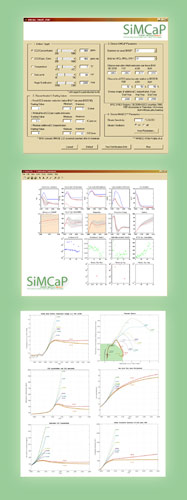
> Publications
> Model
> Data
Here, some of the data is offered for download that
has been generated by one of the SiMCaP modules. If you should be interested
in using the data for any publications, please contact mmalte@ucar.edu.
Thanks!
![]() .xls 0.5MB
.xls 0.5MB
View data in Excel
![]() .zip 43KB
.zip 43KB
.gas files
for MAGICC 4.1
EQW pathway set 1:
Emission data for CO2 equivalence stabilization & peaking pathways
(EQW)
by Malte Meinshausen, January 2005, using the Equal Quantile Walk (EQW) method
Emission data is presented for 16 greenhouse gases, aerosols and tropospheric ozone precursors. The data includes four pathways that lead to a stabilization of atmospheric concentrations at 550, 500, 450 and 400ppm CO2equivalence (with peaking at 550, 525, 500 and 475ppm, respectively), three peaking pathways at 550, 500, and 475ppm CO2eq and two delayed pathways for stabilization at 400ppm CO2eq. Data is presented in xls, html and .gas files, whith the latter being emission driver files for the MAGICC 4.1 model, developed by Tom Wigley, Sarah Rapher et al.
![]() .zip 4.0MB
.zip 4.0MB
all data zipped
EQW pathway set 1:
Climate data for CO2 equivalence stabilization & peaking pathways
(EQW)
by Malte Meinshausen, January 2005, using the Equal Quantile Walk (EQW) method, SiMCaP QuickCruncher and MAGICC 4.1
The consequences for atmospheric concentration, radiative forcing, temperature, and sea level are computed for 9 different stabilization and peaking pathways (see corresponding emission data above). Here, data is given for the '7 AOGCM ensemble mean' using the simple climate model MAGICC 4.1 embedded in the SiMCaP module 'QuickCruncher'. Note that this data on the climate consequences of the above given emission pathways does not contain uncertainty ranges in respect to climate sensitivity, ocean diffusivity etc, but just the ensemble mean over best fits to 7 AOGCMs as used in the IPCC TAR (see WGI, Appendix 9.1). The data includes four pathways that lead to a stabilization of atmospheric concentrations at 550, 500, 450 and 400ppm CO2equivalence (with peaking at 550, 525, 500 and 475ppm, respectively). These stabilization outputs are named SXXXCe, where XXX indicates the CO2 equivalence stabilization level. Furthermore, three peaking pathways at 550, 500, and 475ppm CO2eq are given, with the names PXXXCe. Two delayed pathways for stabilization at 400ppm CO2eq are named S400Ce2015-2020 and S400Ce2020-2025. Data is presented in zipped MS Excel and html format.
![]() .xls 1.3MB
.xls 1.3MB
View data in Excel
![]() .zip 120KB
.zip 120KB
.gas files
for MAGICC 4.1
EQW pathway set 2:
Emission data for greenhouse gas peaking pathways as in Figure 6 of Meinshausen
et al. "Multi-gas emissions pathways to meet climate targets"
by Malte Meinshausen, September 2005, using the Equal Quantile Walk (EQW) method
![]() Emission
data is presented for 16 greenhouse gases, aerosols and tropospheric ozone
precursors.
Emission
data is presented for 16 greenhouse gases, aerosols and tropospheric ozone
precursors.
Left panels: The data includes 15 pathways that start departing from the median of 54 IPCC SRES & post-SRES scenarios by 2010 and follow different reduction rates thereafter.
Right panels: Additionally, the data for nine pathways is given that all share the same reduction rate of the driver path (-3%/yr for OECD fossil CO2 emissions), but with different departure years from the median SRES & post-SRES path.
These pathways are those depicted in Figure 6 in Meinshausen et al. "Multi-gas emissions pathways to meet climate targets "
![]() .xls 300KB
.xls 300KB
View data in Excel
![]() .zip 27KB
.zip 27KB
.gas files
for MAGICC 4.1
EQW pathway set 3:
Emission data for greenhouse gas peaking pathways as in Figure 4 of Meinshausen
et al. "Multi-gas emissions pathways to meet climate targets"
by Malte Meinshausen, October 2005, using the Equal Quantile Walk (EQW) method
![]() Emission
data is presented for 16 greenhouse gases, aerosols and tropospheric ozone
precursors.
Emission
data is presented for 16 greenhouse gases, aerosols and tropospheric ozone
precursors.
These pathways are those depicted in Figure 4 in Meinshausen et al. "Multi-gas emissions pathways to meet climate targets "
![]() .zip 2.0MB
.zip 2.0MB
all data zipped
as MS Excel files
EQW pathway set 3:
Climate data for greenhouse gas peaking pathways as in Figure 4 of Meinshausen
et al. "Multi-gas emissions pathways to meet climate targets"
by Malte Meinshausen, October 2005, using the Equal Quantile Walk (EQW) method, SiMCaP QuickCruncher and MAGICC 4.1
The consequences for atmospheric concentration, radiative forcing, temperature, and sea level are computed for 5 different CO2 stabilization pathways (see corresponding emission data set 3 above). Here, data is given for the '7 AOGCM ensemble mean' using the simple climate model MAGICC 4.1 embedded in the SiMCaP module 'QuickCruncher'. Note that this data on the climate consequences of the above given emission pathways does not contain uncertainty ranges in respect to climate sensitivity, ocean diffusivity etc, but just the ensemble mean over best fits to 7 AOGCMs as used in the IPCC TAR (see WGI, Appendix 9.1). These IPCC TAR "best-guess" stabilization outputs are named EQW-SXXXC, where XXX indicates the CO2 stabilization level in ppm. Data is presented in zipped MS Excel and html format.
by Malte Meinshausen, revised version of data appendix in F. Yamin and J. Depledge, "The International Climate Change Regime: A Guide to Rules, Institutions, and Procedures", Cambridge University Press, 2004
This appendix sets out information about Annex I Parties' GHG emissions, including whether each Party has achieved the 'stabilisation aim' under the UN Framework Convention on Climate Change and is likely to achieve its quantified commitments under the Kyoto Protocol. It also sets out such information for a number of Annex I Party groupings, such as Annex I, Annex II, the EU-15/25, Economies in Transition, and JUSSCANNZ. This version supersedes the one published in F. Yamin and J. Depledge, "The International Climate Change Regime: A Guide to Rules, Institutions, and Procedures", Cambridge University Press, 2004 (unfortunate production error).